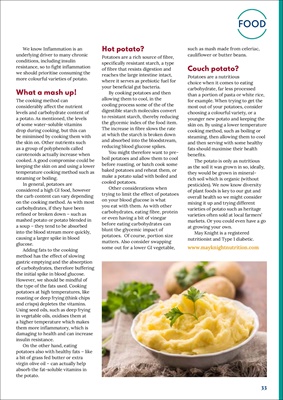
33
FOOD
We know Inflammation is a
underlying driver to many chronic
conditions, including insulin
resistance, so to fight inflammation
we should prioritise consuming the
more colourful varieties of potato.
What a mash up!
The cooking method can
considerably affect the nutrient
levels and carbohydrate content of
a potato. As mentioned, the levels
of some water-soluble vitamins
drop during cooking, but this can
be minimised by cooking them with
the skin on. Other nutrients such
as a group of polyphenols called
carotenoids actually increase when
cooked. A good compromise could be
keeping the skin on and using a lower
temperature cooking method such as
steaming or boiling.
In general, potatoes are
considered a high GI food, however
the carb content can vary depending
on the cooking method. As with most
carbohydrates, if they have been
refined or broken down - such as
mashed potato or potato blended in
a soup - they tend to be absorbed
into the blood stream more quickly,
causing a larger spike in blood
glucose.
Adding fats to the cooking
method has the effect of slowing
gastric emptying and the absorption
of carbohydrates, therefore buffering
the initial spike in blood glucose.
However, we should be mindful of
the type of the fats used. Cooking
potatoes at high temperatures, like
roasting or deep frying (think chips
and crisps) depletes the vitamins.
Using seed oils, such as deep frying
in vegetable oils, oxidises them at
a higher temperature which makes
them more inflammatory, which is
damaging to health and can increase
insulin resistance.
On the other hand, eating
potatoes also with healthy fats - like
a bit of grass fed butter or extra
virgin olive oil - can actually help
absorb the fat-soluble vitamins in
the potato.
Hot potato?
Potatoes are a rich source of fibre,
specifically resistant starch, a type
of fibre that resists digestion and
reaches the large intestine intact,
where it serves as prebiotic fuel for
your beneficial gut bacteria.
By cooking potatoes and then
allowing them to cool, in the
cooling process some of the of the
digestible starch molecules convert
to resistant starch, thereby reducing
the glycemic index of the food item.
The increase in fibre slows the rate
at which the starch is broken down
and absorbed into the bloodstream,
reducing blood glucose spikes.
You might therefore want to preboil potatoes
and allow them to cool
before roasting, or batch cook some
baked potatoes and reheat them, or
make a potato salad with boiled and
cooled potatoes.
Other considerations when
trying to limit the effect of potatoes
on your blood glucose is what
you eat with them. As with other
carbohydrates, eating fibre, protein
or even having a bit of vinegar
before eating carbohydrates can
blunt the glycemic impact of
potatoes. Of course, portion size
matters. Also consider swapping
some out for a lower GI vegetable,
such as mash made from celeriac,
cauliflower or butter beans.
Couch potato?
Potatoes are a nutritious
choice when it comes to eating
carbohydrate, far less processed
than a portion of pasta or white rice,
for example. When trying to get the
most out of your potatoes, consider
choosing a colourful variety, or a
younger new potato and keeping the
skin on. By using a lower temperature
cooking method, such as boiling or
steaming, then allowing them to cool
and then serving with some healthy
fats should maximise their health
benefits.
The potato is only as nutritious
as the soil it was grown in so, ideally,
they would be grown in mineralrich soil which is organic
(without
pesticides). We now know diversity
of plant foods is key to our gut and
overall health so we might consider
mixing it up and trying different
varieties of potato such as heritage
varieties often sold at local farmers'
markets. Or you could even have a go
at growing your own.
May Knight is a registered
nutritionist and Type 1 diabetic.
www.mayknightnutrition.com